Feedback Loops  Concepts
Concepts
|
In any physical or social system, complex interactions sometimes act to accelerate a process while other interactions will retard that process. A classic example of an accelerating process is a "run on the bank" in which economic panic sends a large volume of shareholders to the bank to withdraw their assets. The massive withdrawal accelerates panic and leads to more economic disruption! This is an example of a positive feedback loop - a cycle in which two agents act to reinforce the other's action, leading to an acceleration or amplification of a situation. |

|
|
Negative feedbacks on the other hand tend to dampen or buffer processes; this tends to make systems more stable by bringing processes to a state of equilibrium. A common example is when people get hot and perspire and evaporative cooling along the surface of the skin results in a reduction in body temperature. Clearly, when we're talking about feedbacks, "negative" is usually a good thing and "positive" is anything but. These terms refer to the process, not the outcome. It is through positive feedback mechanisms that small changes can lead to large ones. Positive feedbacks in the climate system are contributing to increasing rates of climate change.
|
||
